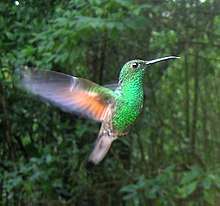Stripe-tailed hummingbird
The stripe-tailed hummingbird (Eupherusa eximia) is a species of hummingbird endemic to subtropical moist forest and adjacent clearings of Middle America, from the Gulf slope of southeastern Mexico to Panama.
| Stripe-tailed hummingbird | |
|---|---|
 | |
| Scientific classification | |
| Kingdom: | Animalia |
| Phylum: | Chordata |
| Class: | Aves |
| Order: | Apodiformes |
| Family: | Trochilidae |
| Genus: | Eupherusa |
| Species: | E. eximia |
| Binomial name | |
| Eupherusa eximia (DeLattre, 1843) | |
 | |
| Range of E. eximia | |
Description
This medium-sized hummingbird can measure up to 10 cm (3.9 in) long, and weigh up to 4.3 g (0.15 oz). The male has metallic green upperparts that grade to bronze at the rump and tail. It sports a conspicuous rufous wing patch when the wings are folded. The underwing is mostly rufous-cinnamon. The namesake striped tail is formed by dark bronze green central rectrices and outer rectrices which have black outer webs, white inner webs and broad black tips. The female has a metallic green back but her underparts and the sides of her face are light brownish grey. On both sexes, the bill is straight and black.[2]
The female lays two white eggs in a small cup nest lined with plant fibres.
The white-tailed hummingbird and the Oaxaca hummingbird are sometimes considered subspecies of this species.
References
- BirdLife International (2012). "Eupherusa eximia". IUCN Red List of Threatened Species. 2012. Retrieved 26 November 2013.CS1 maint: ref=harv (link)
- Arizmendi, M.C.; Rodríguez-Flores, C.; Soberanes-González, C.; Schulenberg, Thomas S. (2013). Schulenberg, T.S. (ed.). "Stripe-tailed Hummingbird (Eupherusa eximia)". Neotropical Birds Online. Ithaca: Cornell Lab of Ornithology. Retrieved 27 July 2014. External link in
|website=(help)
External links
| Wikimedia Commons has media related to Eupherusa eximia. |
| Wikispecies has information related to Eupherusa eximia |
- "Stripe-tailed hummingbird media". Internet Bird Collection.
- Stripe-tailed hummingbird photo gallery at VIREO (Drexel University)
